Experimental Study on Durability of Hybrid Fiber-Reinforced Concrete in Deep Alluvium Frozen Shaft Lining
Abstract
:1. Introduction
2. Preparation of Hybrid Fiber-Reinforced Concrete for Shaft Lining
2.1. Raw Materials
2.2. Test Mix Ratio
2.3. Preparation and Curing of Specimens
2.4. Test Results and Analysis
3. Durability Test of Shaft Lining Hybrid Fiber-Reinforced Concrete
3.1. Impermeability Test
3.1.1. Experimental Design
- After the maintenance of specimens was completed, the surface of each specimen was polished to remove the influence of surface floating slurry.
- Paraffin was heated and melted in a shallow dish, and then, a layer of paraffin with a thickness of about 1.5 mm was applied around the specimen to seal the water.
- The cylindrical paraffin-wrapped specimen was placed into a preheated metal sleeve die; and left to sink slowly, and then pressed to level with the bottom of the sleeve die.
- After cooling, the specimens were installed in turn, the fixing screws were tightened; and the parameters of the antipermeability meter were adjusted. The loading was set as follows: Upper limit of 4 MPa, lower limit of 3.6 MPa; and the pressure was continuously stabilized for 24 h.
- After the test was completed, the sleeve mold was removed, and a press was used to demold and split the specimen to observe the section. Ten measuring points were taken from each specimen, and the water seepage height at each point was measured. A flow chart of the operation steps is shown in Figure 7.
3.1.2. Test Results and Analysis
3.2. Freeze–Thaw Resistance Cycle Test
3.2.1. Experimental Design
3.2.2. Test Results and Analysis
3.3. Sulfate Corrosion Resistance Test
3.3.1. Experimental Design
3.3.2. Test Results and Analysis
4. Discussion
5. Conclusions
- Under the design strength of C60, the compressive strength of the hybrid fiber group was the same as that of the reference group, with an increase of −5.5~3.0%, while the splitting tensile strength and flexural strength were significantly higher than those of the reference group, with a maximum increase of 32.4% and 25.6%, respectively. At the same time, the optimum content of hybrid fiber in this experiment was determined as 1.092 kg/m3 PVA fiber and 5 kg/m3 FST fiber.
- According to the impermeability test results, the average impermeability height and relative permeability coefficient of the hybrid fiber concrete were reduced by 31.7% and 53.3%, respectively, compared with the reference group, which indicates that the hybrid fiber can significantly improve the impermeability of concrete; and enable it to meet the impermeability requirements for frozen shaft lining concrete, which is in accordance with the conclusion of the impermeability test of hybrid fiber conducted by Yang, L. et al. [21].
- Through the freeze–thaw resistance cycle test, it found that after 100 freeze–thaw cycles, the mass loss rate and strength loss of the hybrid fiber concrete were reduced by 78.3% and 2.57%, respectively, compared with those of the reference concrete, which is similar to the results of the freeze–thaw test of fiber-reinforced concrete carried out by Zhao, X. M. et al. [22]. Additionally, the group of hybrid fiber concrete still maintained a higher bearing capacity and a better apparent morphology, which indicates that the hybrid fiber can improve the frost resistance of concrete.
- According to the sulfate corrosion resistance test results, after soaking in sulfate solution for 120 days, the mass and strength of the hybrid fiber-reinforced concrete increased rather than decreasing; its strength still maintained a high level. It shows that hybrid fiber-reinforced concrete has good corrosion resistance and can meet the requirements for long-term use in harsh underground environments.
Author Contributions
Funding
Institutional Review Board Statement
Informed Consent Statement
Data Availability Statement
Conflicts of Interest
References
- Xie, H.P. Research review of the state key research development program of China: Deep rock mechanics and mining theory. J. China Coal Soc. 2019, 44, 1283–1305. [Google Scholar]
- He, M.C. Research progress of deep shaft construction mechanics. J. China Coal Soc. 2021, 46, 726–746. [Google Scholar]
- Yang, H. Design of shaft freezing construction in thick surface soil. Coal Sci. Technol. 2019, 40, 62–64. [Google Scholar]
- Wang, X.S.; Cheng, H.; Wu, T.L.; Yao, Z.S.; Huang, X.W. Numerical analysis of a novel shaft lining structure in coal mines consisting of hybrid-fiber-reinforced concrete. Crystals 2020, 10, 928. [Google Scholar] [CrossRef]
- Jia, C.G. The design of shaft lining structure in extra thick alluvium of deep shaft by freeze sinking method. Mine Constr. Technol. 2019, 40, 1–4. [Google Scholar]
- Wang, J.P.; Liu, W.M.; Wang, H. Comparisions on ground freezing constructions in 1000m depth mine shaft. Mine Constr. Technol. 2017, 38, 34–37. [Google Scholar]
- Li, J.Z.; Gao, W.; Chen, Z.P.; Peng, F. Status and outlook of over C80 high strength and high performance concrete technology applied to shaft liner by freezing sinking method in China coal mine. Mine Construct Techno. 2018, 39, 45–48. [Google Scholar]
- Li, J.Z.; Gao, W.; Li, F.Z. New progress of theory and technology in deep shaft sinking by artificial ground freezing method. Mine Constr. Technol. 2020, 41, 10–14. [Google Scholar]
- Zhang, S.P.; He, P.L.; Niu, L.L. Mechanical properties and permeability of fiber-reinforced concrete with recycled aggregate made from waste clay brick. J. Clean. Prod. 2020, 26, 918–922. [Google Scholar] [CrossRef]
- Yao, Z.S.; Chen, H.; Sun, W.R. Experimental study on high strength composite shaft lining in deep alluvium. J. Rock. Soil Mech. 2003, 5, 739–743. [Google Scholar]
- Zhang, T.; Yang, W.H.; Chen, G.H.; Huang, J.H.; Hang, T.; Zhang, C. Monitoring and analysis of hydration heat temperature field for high performance mass concrete freezing shaft lining. J. Min. Saf. Eng. 2016, 33, 290–296. [Google Scholar]
- Guo, L. Study on the Inhomogeneity of Horizontal Lateral pressure on Shaft Lining. Doctor’s Thesis, University of Mining and Technology, Beijing, China, 2010. [Google Scholar]
- Dai, C. Analysis of Deep Alluvium Freezing Shaft Wall Mechanical Properties. Master’s Thesis, Anhui University of Science and Technology, Huainan, China, 2017. [Google Scholar]
- Jiang, L.H.; Xu, H.D.; Chu, H.Q.; Wang, M.J.; Xu, L. Development and application of high strength and high performance concrete to mine freezing shaft. Coal Sci. Technol. 2010, 38, 38–41. [Google Scholar]
- Peng, S.L.; Rong, C.X.; Cheng, H.; Wang, X.J.; Li, M.J.; Tang, B.; Li, X.M. Mechanical Properties of High-Strength High-Performance Reinforced Concrete Shaft Lining Structures in Deep Freezing Wells. Adv. Civ. Eng. 2019, 21, 69–78. [Google Scholar] [CrossRef]
- Yang, Y. The Preparation and Performance Research of Freezing Shaft Lining C80 HPC in Extraordinary Depth Surface Soil. Master’s Thesis, Anhui University of Science and Technology, Huainan, China, 2006. [Google Scholar]
- Shan, F.D. Common problems and countermeasures in design and construction of mine shaft equipment. Mine Constr. Technol. 2016, 37, 38–40. [Google Scholar]
- Li, Y.; Li, B.; Zhang, L.Y.; Ma, C.; Zhu, J.; Li, M.; Pu, H. Chloride Ion Corrosion Pattern and Mathematical Model for C60 High-Strength Concrete after Freeze-Thawing Cycles. Adv. Civ. Eng. 2021, 6, 32–40. [Google Scholar]
- Xue, W.P. Research on Coupled Damage Evolution Mechanism and Strength Characteristics of Shaft Lining Concrete Under High Pressure Water. Doctor’s Thesis, Anhui University of Science and Technology, Huainan, China, 2017. [Google Scholar]
- Jiang, X.Q.; Cao, D.F.; Ge, W.J.; Zhang, Y. Effect of freeze-thaw cycle and chloride corrosion on bond properties between steel bar and concrete. J. Yangzhou Univ. Nat. Sci. Ed. 2017, 20, 69–74. [Google Scholar]
- Yang, L.; Yao, Z.S.; Xue, W.P.; Wang, X.S.; Kong, W.H.; Wu, T.L. Preparation performance test and microanalysis of hybrid–fibers and microexpansive high-performance shaft lining concrete. Constr. Build. Mater. 2019, 223, 431–440. [Google Scholar] [CrossRef]
- Zhao, X.M.; Li, A.Y.; Qiao, H.X.; Li, J.C.; Wang, X.K. Frost resistance and damage deterioration model of fiber-reinforced concrete. Bull. Chin. Ceram. Soc. 2020, 39, 3196–3202. [Google Scholar]
- Yang, D.; Yan, C.; Liu, S. Spliting Tensile Strength of Concerte Corroded by Saline Soil. ACI. Mater. J. 2020, 32, 137–145. [Google Scholar]
- Hou, Y.F.; You, S.; Ji, H.G. Experimental study on corrosion characteristics of concrete shaft lining by ultrasonic detection. In Proceedings of the 3rd ISRM Young Scholars’ Symposium on Rock Mechanics, Xian, China, 8–10 November 2014; pp. 285–290. [Google Scholar]
- Liu, J.H.; Chen, Z.M.; Ji, H.G. Study of the performance of shaft concrete mixed with imitation steel fiber under the coupling of early age load and negative temperature. J. China Coal Soc. 2013, 38, 2140–2145. [Google Scholar]
- China Standards Publication. Standard Test Methods for Fiber Reinforced Concrete; CECS/13-2009; Standard Press of China: Beijing, China, 2009. [Google Scholar]
- Han, J.H.; Zou, J.Q.; Yang, W.H.; Hu, C.C. Mechanism of Fracturing in Shaft Lining Caused by High-Pressure Pore Water in Stable Rock Strata. Math. Probl. Eng. 2019, 12, 132–140. [Google Scholar] [CrossRef]
- Liu, T.Y.; Zhang, P.; Li, Q.F.; Hu, S.W.; Ling, Y.F. Durability Assessment of PVA Fiber-Reinforced Cementitious Composite Containing Nano-SiO2 Using Adaptive Neuro-Fuzzy Inference System. Crystals 2020, 10, 347. [Google Scholar] [CrossRef]
- Yu, X.F.; Dong, Y.W.; Wang, G.; Lu, H.L. Durability of fly ash concrete against sulfate erosion in complex environment. Concrete 2020, 6, 58–69. [Google Scholar]
- Anwar, A.Y.; Moetaz, E.H.; Khallad, N.; Khan, P.B. Corrosion resistance of recycled aggregate concrete incorporating slag. ACI. Mater. J. 2020, 117, 111–122. [Google Scholar]
- China Standards Publication. Standard for Test Methods of Long–Term Performance and Durability of Ordinary Concrete; GBT/50082-2009; Standard Press of China: Beijing, China, 2009. [Google Scholar]
- Yang, M.F.; Ni, X.Q.; Wang, X. Complex multi function anti-freeze influenced to durability of minus temperature mine shaft liner concrete. Coal Sci. Technol. 2010, 38, 47–49. [Google Scholar]
- Ni, X.Q.; Yang, M.F. Research and application of frost-resistant, impermeable, high-strength and high-flow shaft lining concrete. J. Min. Saf. Eng. 2004, 1, 27–32. [Google Scholar]
- Jiang, J.H.; Wen, W.X.; Qiu, J.Q. Corrosion behaviors of concrete exposed to sulfate attack with simulated groundwater pressure. J. Hebei Univ. Eng. Nat. Sci. Ed. 2019, 3, 11–15. [Google Scholar]
- Limeira, J.; Etxeberria, M.; Agulló, L.; Molina, D. Mechanical and durability properties of concrete made with dredged marine sand. Constr. Build. Mater. 2011, 25, 4165–4174. [Google Scholar] [CrossRef]
- Zhao, L.; Liu, J.H.; Zhou, W.J.; Ji, H.G. Damage evolution and mechanism of concrete erosion at sulfate environment in undergroundmine. J. China Coal Soc. 2016, 41, 1422–1428. [Google Scholar]


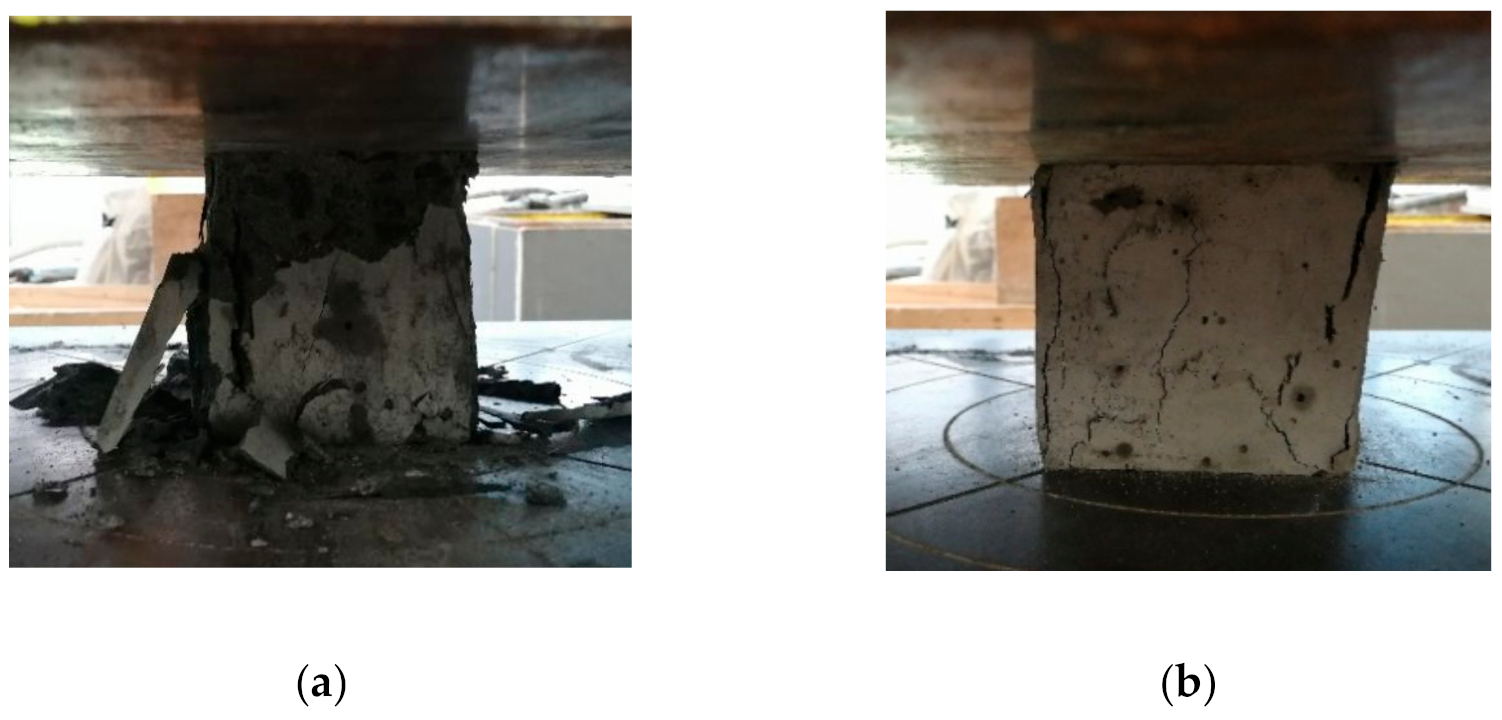

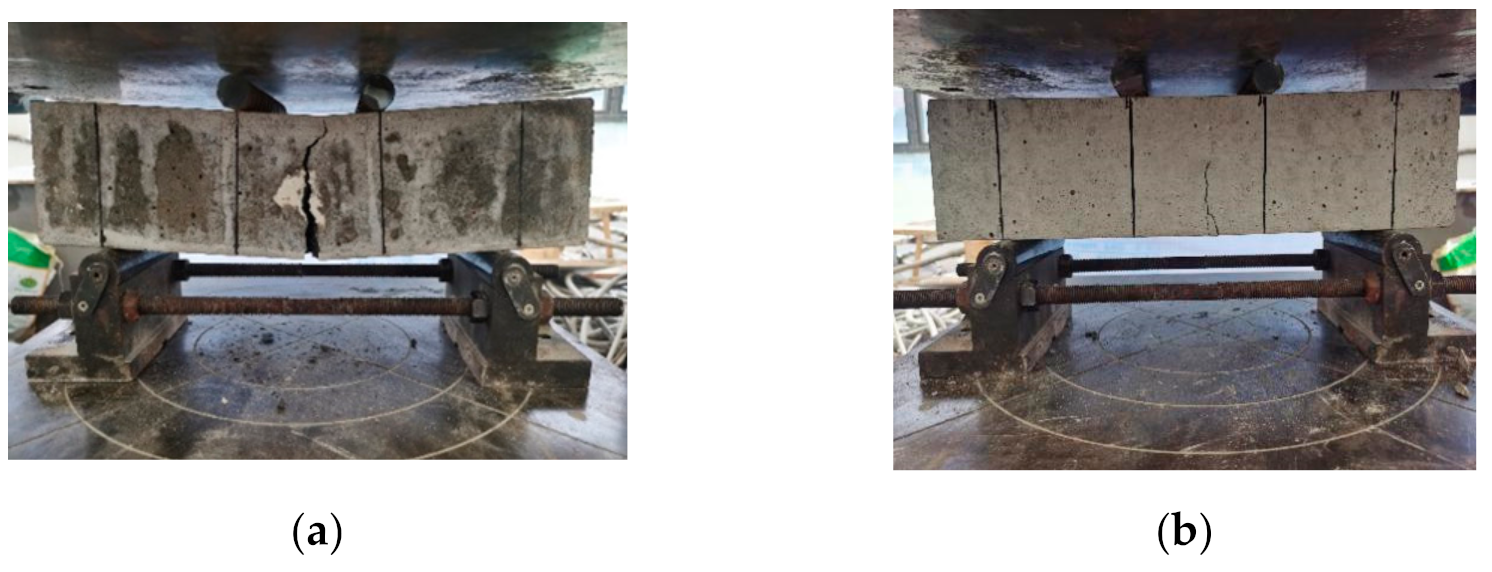
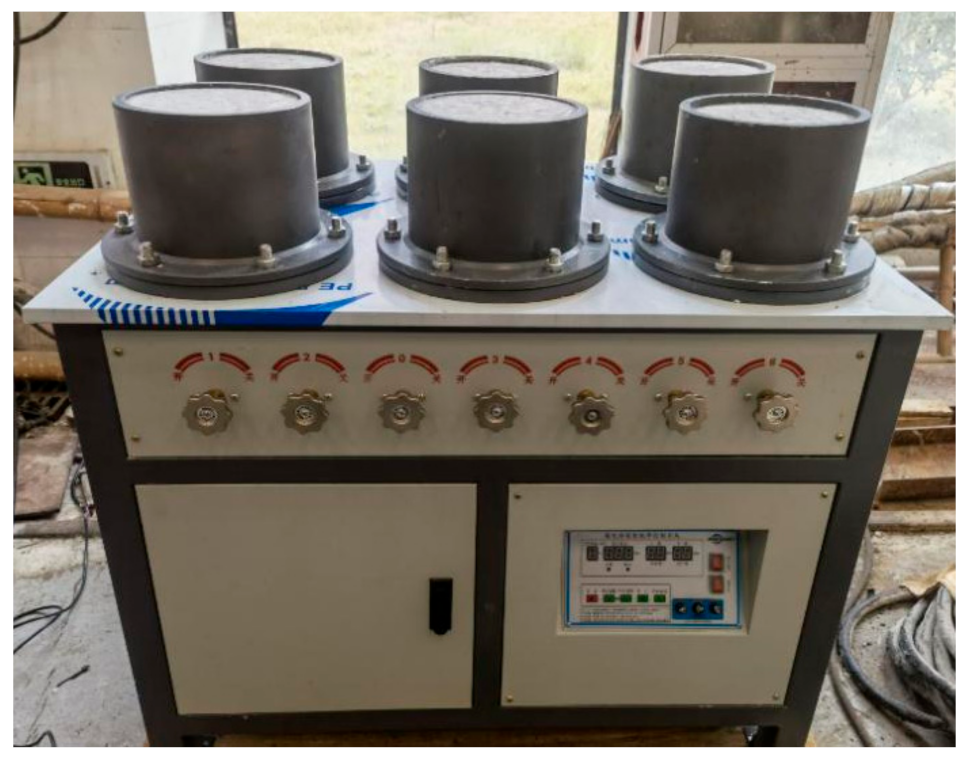


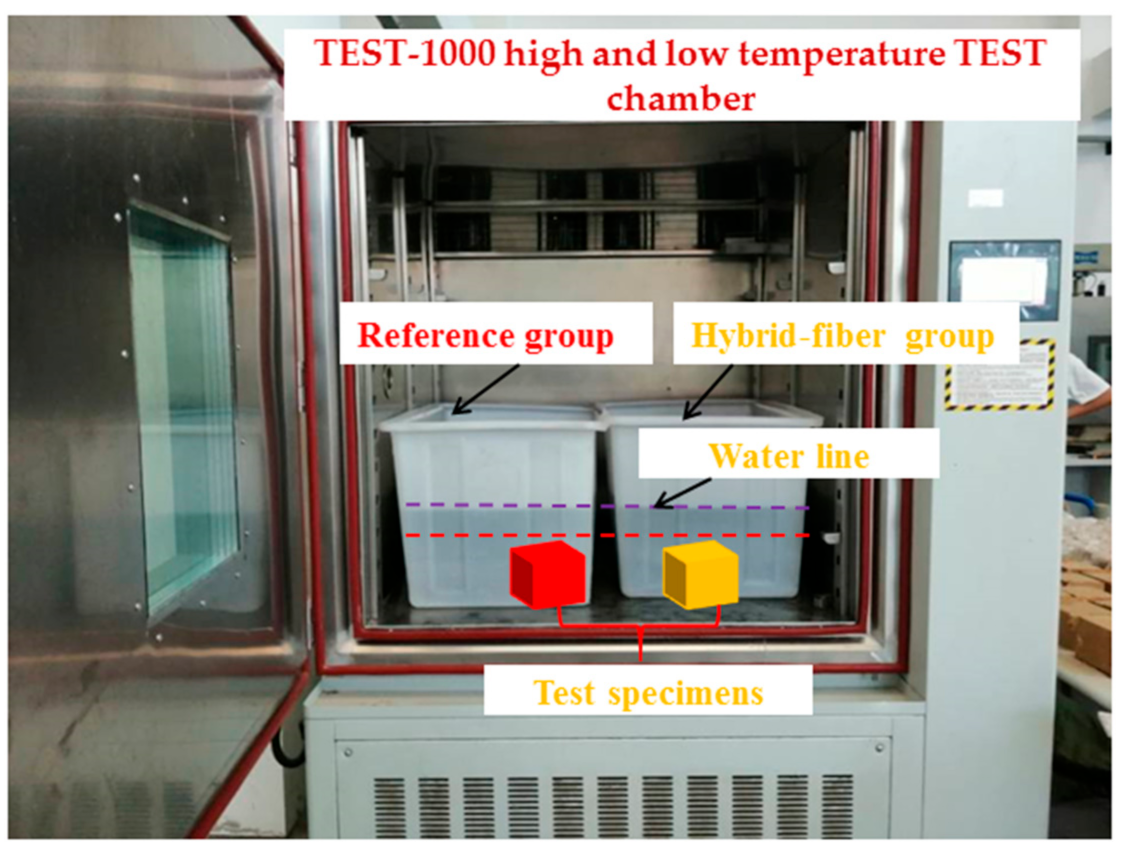

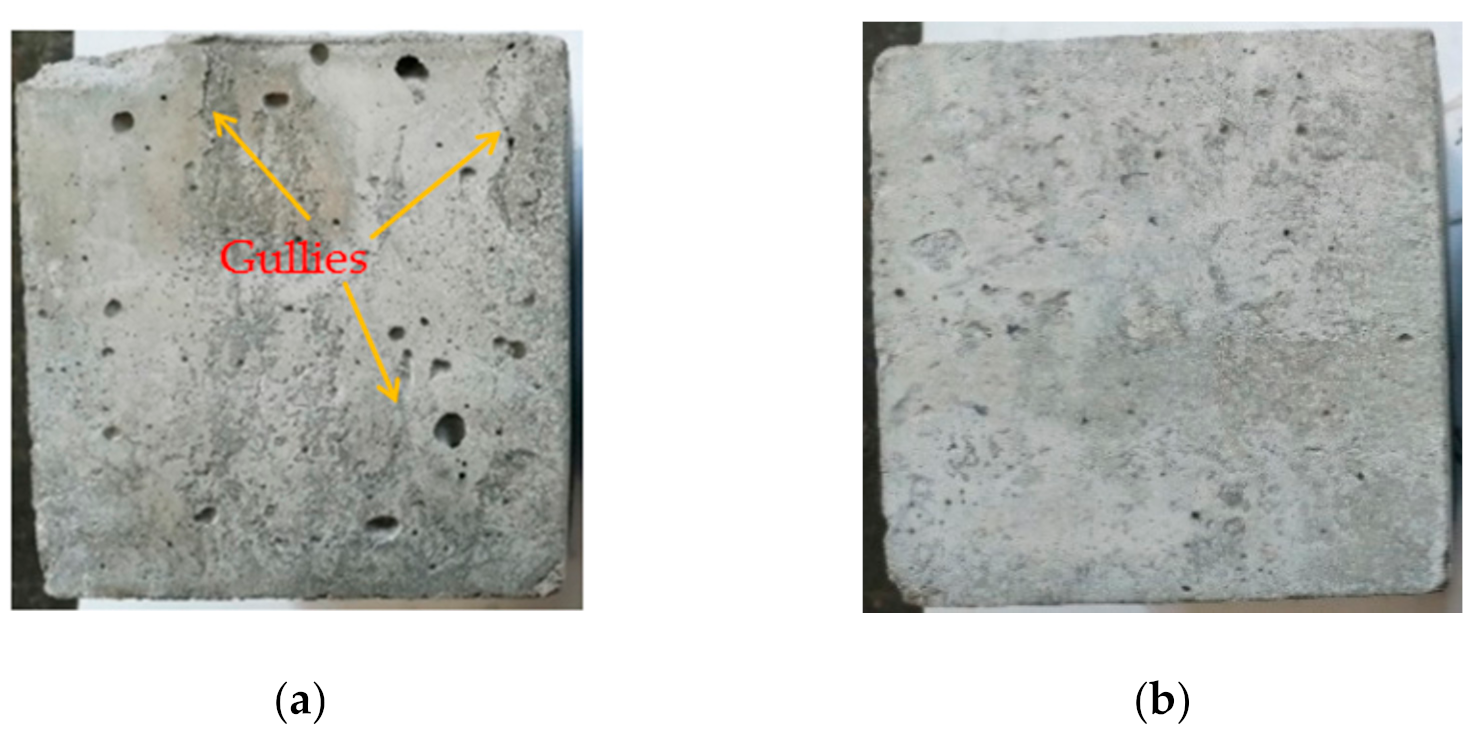


| Cement Type | Stability | Setting Time (min) | Flexural Strength (MPa) | Compressive Strength (MPa) | |||
|---|---|---|---|---|---|---|---|
| Initial setting | Final setting | 3d | 28d | 3d | 28d | ||
| P.O 52.5R | Qualified | 120 | 280 | 7.2 | 10.9 | 34.5 | 57.8 |
| Square Screen Size (mm) | Remaining Percentage of Screen (%) | Cumulative Sieve Residual Percentage (%) |
|---|---|---|
| 4.75 | 1.3 | 1.3 |
| 2.36 | 11.0 | 12.3 |
| 1.18 | 13.1 | 25.4 |
| 0.6 | 26.5 | 51.9 |
| 0.3 | 41.8 | 93.7 |
| 0.15 | 3.8 | 97.5 |
| Amount at the bottom of the screen | 2.5 | 100.0 |
| Total | 100.0 | 100.0 |
| Fineness modulus | 2.934 | |
| Admixtures | Component (%) | ||||||
|---|---|---|---|---|---|---|---|
| SiO2 | Al2O3 | Fe2O3 | CaO | MgO | SiO2 | SO3 | |
| Slag powder | 32.41 | 9.99 | 1.50 | 40.32 | 6.86 | 32.41 | 2.51 |
| Silicon powder | 93.60 | 0.78 | 0.65 | 0.82 | 1.30 | 93.60 | 0.10 |
| Water Reducing Rate (%) | Color | Density (kg/m3) | Chlorideion Content (%) | Solid Content (%) |
|---|---|---|---|---|
| 21 | Yellow | 1410 | ≤0.3 | ≥90 |
| Fibers | Length (mm) | Elastic Modulus (GPa) | Elongation (%) | Density (g·cm−3) | Tensile Strength (MPa) |
|---|---|---|---|---|---|
| FSTF | 50 | 5 | 24 | 0.91 | 570 |
| PVAF | 18 | 39 | 6.9 | 1.30 | 1830 |
| Strength Grade | Water/Binder Ratio | Cement (kg·m−3) | Admixtures (kg·m−3) | Stone (kg·m−3) | Sand (kg·m−3) | Water (kg·m−3) |
|---|---|---|---|---|---|---|
| C60 | 0.28 | 410 | 130 | 1121.5 | 630.8 | 151.2 |
| Specimen | Concrete Type | PVA (kg·m−3) | FST (kg·m−3) | Slump (mm) | CS (MPa) | Maximum Error Rate of CS (%) | TS (MPa) | Maximum Error Rate of TS (%) | FS (MPa) | Maximum Error Rate of FS (%) |
|---|---|---|---|---|---|---|---|---|---|---|
| J-1 | Reference concrete | 0 | 0 | 195 | 72.4 | 5.6 | 4.54 | 4.3 | 6.34 | 5.9 |
| H-1 | Hybrid fiber concrete | 0.728 | 5 | 178 | 72.0 | 6.4 | 5.55 | 5.1 | 7.12 | 6.8 |
| H-2 | 1.456 | 4 | 165 | 69.5 | 4.5 | 5.31 | 5.6 | 6.98 | 5.2 | |
| H-3 | 1.092 | 5 | 178 | 74.6 | 5.2 | 6.01 | 5.8 | 7.96 | 6.3 | |
| H-4 | 1.092 | 6 | 174 | 71.5 | 7.1 | 5.25 | 6.9 | 7.01 | 5.7 | |
| H-5 | 0.728 | 6 | 185 | 71.1 | 4.9 | 5.22 | 4.2 | 6.94 | 6.1 | |
| H-6 | 1.092 | 4 | 182 | 70.9 | 5.6 | 5.16 | 6.3 | 6.89 | 5.8 | |
| H-7 | 0.728 | 4 | 187 | 70.5 | 6.7 | 5.58 | 5.5 | 7.28 | 4.9 | |
| H-8 | 1.456 | 5 | 168 | 69.6 | 4.2 | 5.97 | 4.7 | 7.87 | 5.8 | |
| H-9 | 1.456 | 6 | 160 | 68.4 | 3.9 | 5.32 | 4.4 | 7.06 | 4.7 |
| Specimen Groups | Water Penetration Height (cm) | Average Value | Relative Permeability Coefficient (10−7cm/h) | |||||
|---|---|---|---|---|---|---|---|---|
| 1 | 2 | 3 | 4 | 5 | 6 | |||
| Reference group | 2.02 | 1.81 | 1.53 | 1.87 | 1.82 | 1.75 | 1.80 | 0.563 |
| Hybrid fiber group | 1.15 | 0.96 | 1.34 | 1.25 | 1.42 | 1.27 | 1.23 | 0.263 |
| Specimen Groups | Number of Freeze–Thaw Cycles (Times) | ||||
|---|---|---|---|---|---|
| 0 | 25 | 50 | 75 | 100 | |
| Reference group | 0 | –0.10 | –0.16 | 0.02 | 0.23 |
| Hybrid fiber group | 0 | –0.04 | –0.06 | –0.02 | 0.05 |
| Specimen Groups | Corrosion Exposure Time (d) | ||||
|---|---|---|---|---|---|
| 0 | 30 | 60 | 90 | 120 | |
| Reference group | 0 | 0.17 | 0.41 | 0.56 | 0.32 |
| Hybrid fiber group | 0 | 0.08 | 0.24 | 0.31 | 0.14 |
| Specimen Groups | Corrosion Exposure Time (d) | ||||
|---|---|---|---|---|---|
| 0 | 30 | 60 | 90 | 120 | |
| Reference group | 70.3 | 72.3 | 76.1 | 73.4 | 68.5 |
| Hybrid fiber group | 72.2 | 74.1 | 77.2 | 77.6 | 73.7 |
Publisher’s Note: MDPI stays neutral with regard to jurisdictional claims in published maps and institutional affiliations. |
© 2021 by the authors. Licensee MDPI, Basel, Switzerland. This article is an open access article distributed under the terms and conditions of the Creative Commons Attribution (CC BY) license (https://creativecommons.org/licenses/by/4.0/).
Share and Cite
Yao, Z.; Fang, Y.; Zhang, P.; Huang, X. Experimental Study on Durability of Hybrid Fiber-Reinforced Concrete in Deep Alluvium Frozen Shaft Lining. Crystals 2021, 11, 725. https://doi.org/10.3390/cryst11070725
Yao Z, Fang Y, Zhang P, Huang X. Experimental Study on Durability of Hybrid Fiber-Reinforced Concrete in Deep Alluvium Frozen Shaft Lining. Crystals. 2021; 11(7):725. https://doi.org/10.3390/cryst11070725
Chicago/Turabian StyleYao, Zhishu, Yu Fang, Ping Zhang, and Xianwen Huang. 2021. "Experimental Study on Durability of Hybrid Fiber-Reinforced Concrete in Deep Alluvium Frozen Shaft Lining" Crystals 11, no. 7: 725. https://doi.org/10.3390/cryst11070725






